No ferment could be easier than homemade raw apple cider vinegar! The result is one of the best natural remedies featured in 5 Health Benefits of Apple Cider Vinegar & 50+ Unique Ways to Use It!
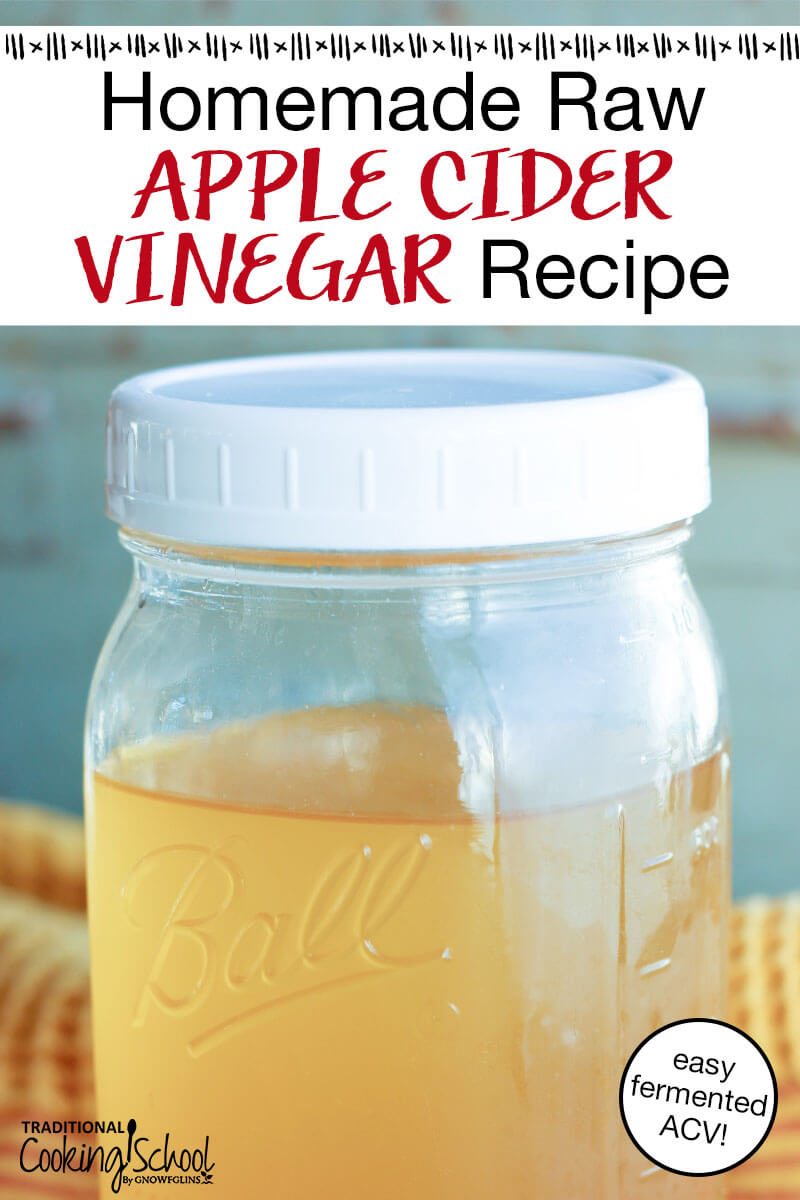
Each fall, where I live, in the Pacific Northwest, there is one good fruit that always goes to waste: apples!
No matter how much people love them, there are still too many. Apple branches hover over their fallen fruit, destined to decompose and feed the scavengers.
My solution? Gallons of homemade apple cider vinegar!
No ferment could be easier. The result is delicious and healthy!
How do you make homemade raw apple cider vinegar?
Many people save up their apple scraps! If you don’t have a bounty of free or inexpensive apples, apple cider vinegar (ACV for short) can be made from apple cores and peels.
Or, whole chopped up apples can be used.
Either way, we combine apples with sugar or honey and water, place the ferment in a warm spot, and wait about 6 weeks.
The hardest part is the waiting.
How much ACV does each batch make?
This recipe produces about 3-1/2 cups of ACV.
But not a lot of measuring is required, so you can make a really big batch without too much more work. You’ll just need more apples and more time to chop them.
Or, you’ll need to save up more cores and apple peels.
Feel free to double, triple, or quadruple this recipe!
Does ACV keep well?
Yes! Once your ACV is made, it is true vinegar, a preserved product. Apple cider vinegar lasts indefinitely at room temperature.
What are some tips to ensure my apple cider vinegar will turn out well?
The most important tips follow:
- As with all ferments, make sure your cutting board, knives, and jars are clean and sterile.
- Keep your ferment warm. Use either a seed mat, a yogurt maker, or, as you’ll see in the photos below, your Instant Pot with steamer insert on the Yogurt setting.
A seed mat is the best option for multiple jars, but any warm spot will do.
Does raw apple cider vinegar have any documented health benefits?
Yes, the acetic acid found in apple cider vinegar has been shown to affect obesity, skin pH, and digestion:
- One study showed that daily intake of vinegar might contribute to weight loss.
- Another study found that ACV improved blood sugar and insulin levels.
- Apple cider vinegar hair rinses help restore the scalp’s and hair’s natural pH balance. (Most hair products aren’t the right pH for the scalp and hair, usually too far on the base side of the pH scale. DIY ACV-based conditioners are slightly acidic.)
- Regarding digestion, apple cider vinegar improves digestion by increasing stomach acid production. ACV may also help the liver to detoxify. (Source.)
- ACV can have multiple antimicrobial effects against various microbial species. (Source.)
How to consume my apple cider vinegar?
- Here’s a basic apple cider vinegar drink recipe. This beverage can be enjoyed before meals or at the start of each day.
- You can also enjoy it in switchels: Try Fizzy Apple Cider Switchel (VAD), Mixed Berry Switchel and Strawberry-Basil Switchel.
- Enjoy as a hot beverage to fight colds in this Apple Cider Vinegar, Honey, Garlic and Lemon Drink.
Note: Apple Cider Vinegar should not be consumed undiluted or applied to the skin undiluted.
What are some common uses for raw apple cider vinegar?
Apple cider vinegar is used not only for hair rinses and to amend the stomach pH. Here are some additional recipes you may enjoy:
- Make Hot and Spicy Tonic to boost the immune system.
- Use ACV to neutralize phytic acid in grains.
- Enjoy ACV bath water for a detox bath and to benefit skin health.
- For use after shampoo, make a DIY ACV hair rinse.
- Find ACV in homemade Sunburn Relief Spray.
- Here are some tips and recipes for cleaning your home with apple cider vinegar.
- Use apple cider vinegar if you raise goats.
Homemade Raw Apple Cider Vinegar Recipe
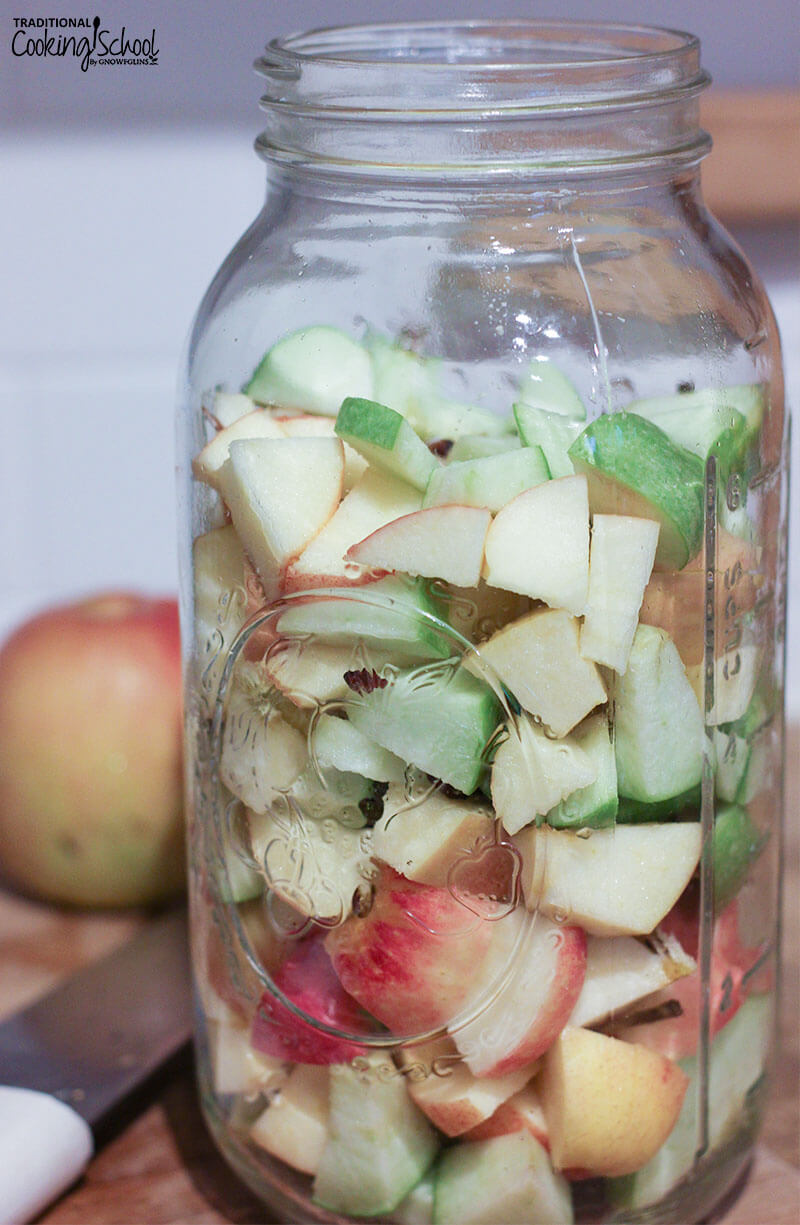
Fill your Mason jar(s) 3/4 of the way with apples or apple scraps.
Stir sugar or honey into warm water until dissolved.
Pour sweetened water over the apples. Leave 2 to 3 inches of room at the top of the jar.
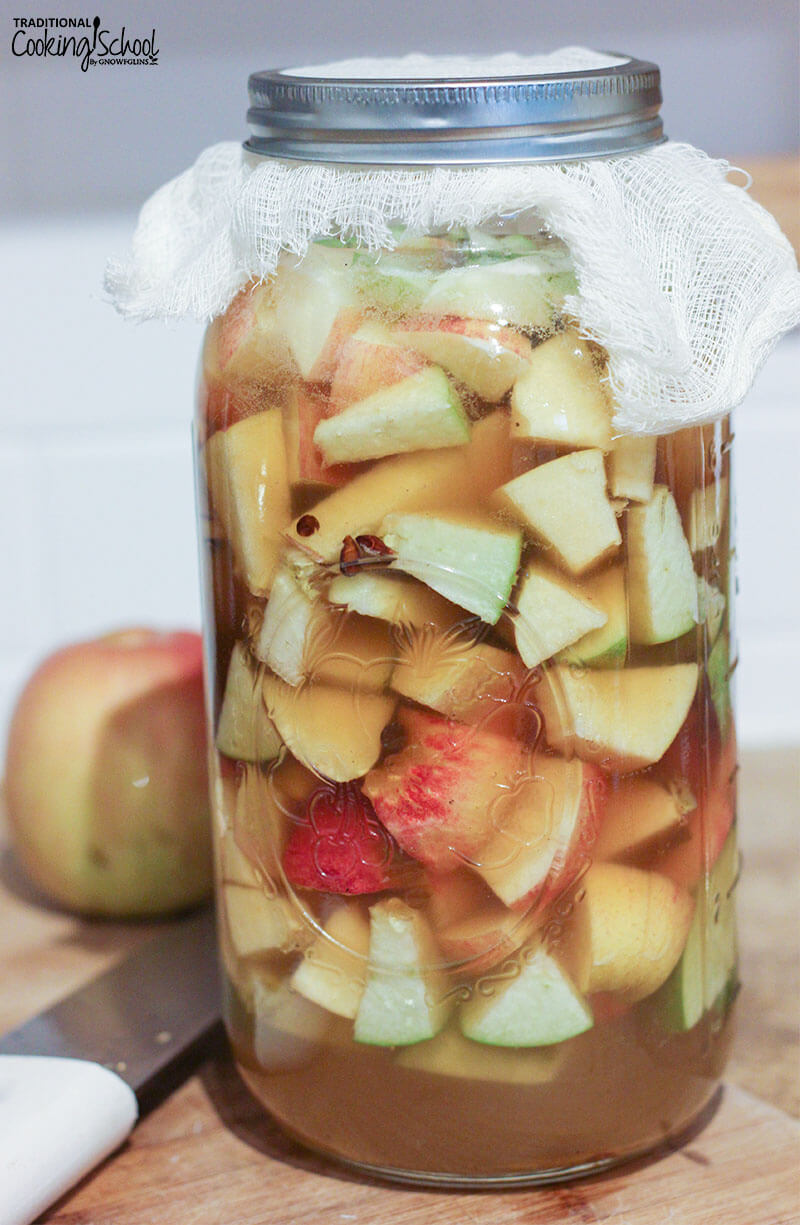
Cover with cheesecloth, thin fabric, or coffee filter and a rubber band or Mason jar screw-top lid.
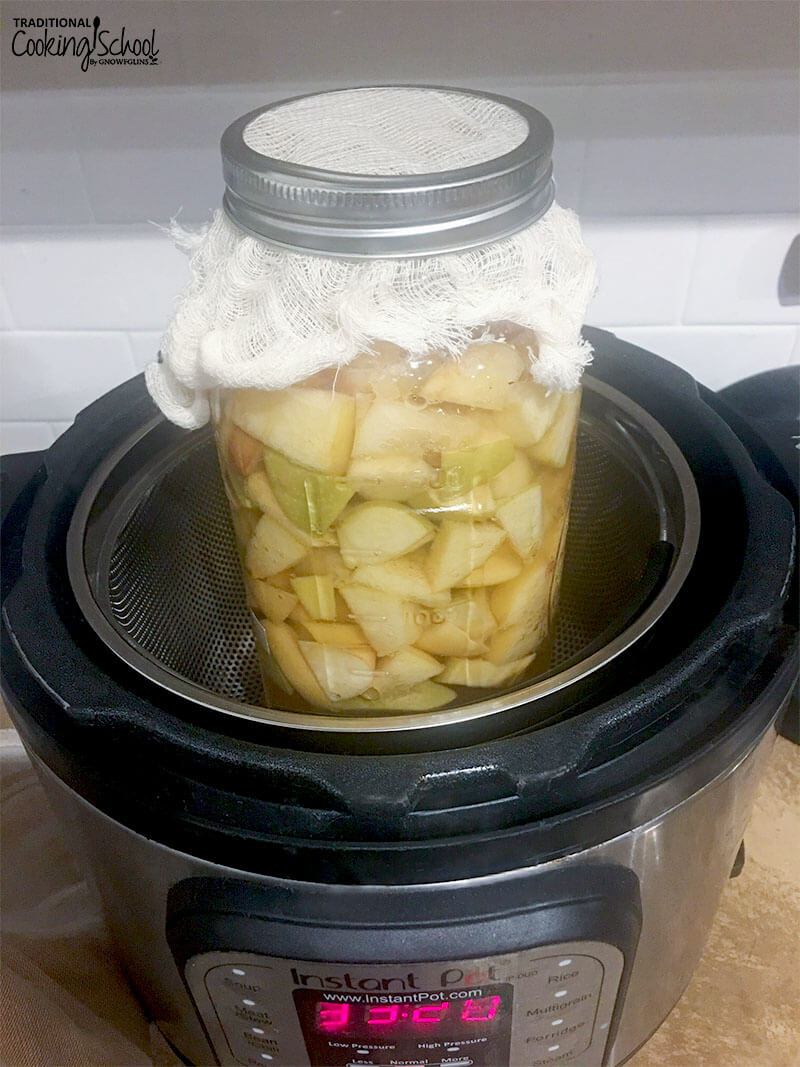
Set in a warm, dark place for 2 weeks. Use either a seed mat, a yogurt maker, or your Instant Pot with steamer insert on the Yogurt setting (as pictured above). You can also simply place it on a warm surface and cover with a tea towel. The smell is wonderful during this process!
After 2 weeks, strain out the solids, pressing on them gently to extract extra liquid.
(Taste the vinegar at this point. It is super delicious!! It’s basically a fermented apple cider!)
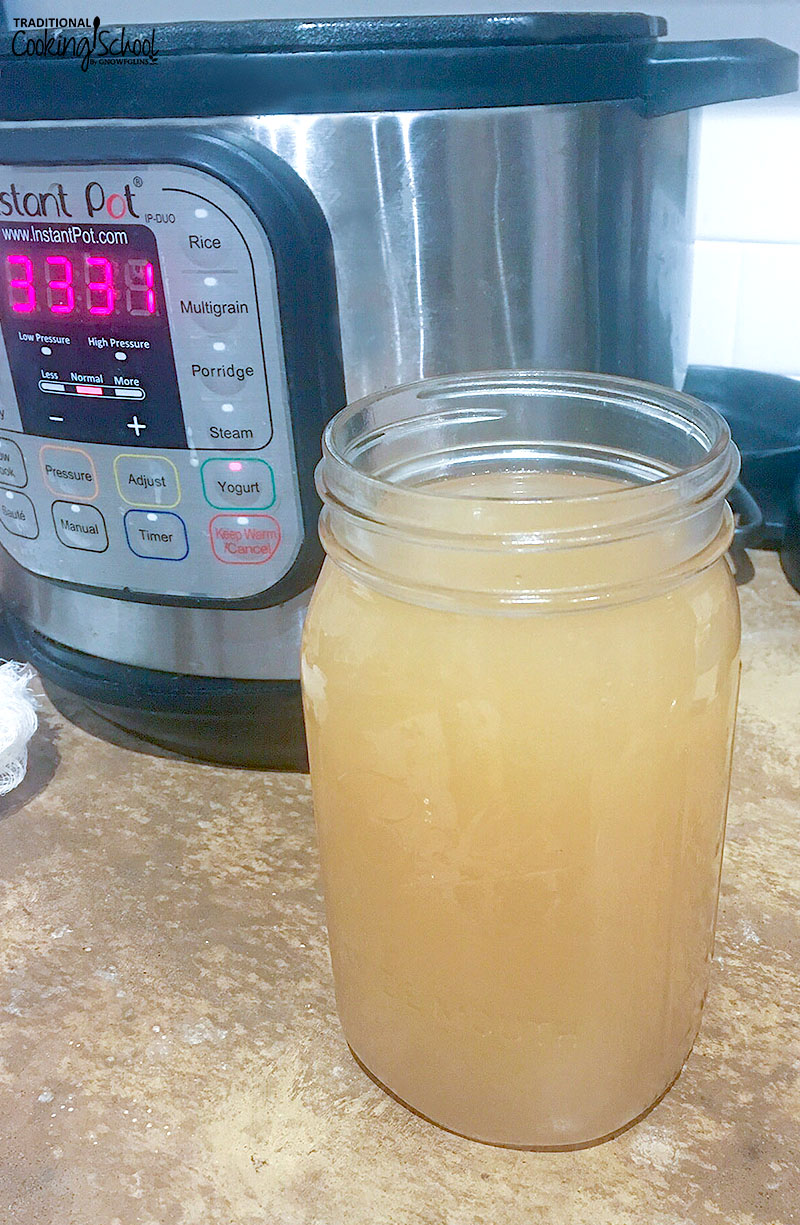
With the solids removed, you will be able to ferment in a smaller jar. Cover with fresh cheesecloth.
Set the fermenting cider in a warm, dark place for about 4 weeks.
The apple cider vinegar is complete when it has a strong apple cider vinegar smell and taste. Allow to ferment longer, if not.
Also, don’t be alarmed if you notice a mother culture forming on top. This is normal!
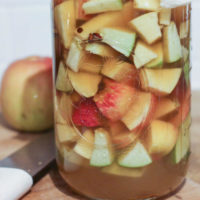
Homemade Apple Cider Vinegar
No ferment could be easier than homemade raw apple cider vinegar! And the result is one of the best natural remedies... promising for weight loss, heartburn, detox, blood sugar, and more.
Ingredients
- 6 cups apples chopped pieces, cores, or peels from (preferably) a variety of apples
- 6 to 7 tablespoons sugar or honey 1 tablespoon for every 1 cup of water used
- 6 to 7 cups pure water warm, but not hot
Instructions
-
Fill Mason jar(s) 3/4 of the way with apples or apple scraps.
-
Stir the sugar or honey into the warm water. Stir to dissolve.
-
Pour sweetened water over the apples. Leave 2 to 3 inches of room at the top of the jar.
-
Cover with cheesecloth, thin fabric or coffee filter and a rubber band or mason jar screw-top lid.
-
Set in a warm dark place for 2 weeks. (Place on a warm surface, and cover with a tea towel. The smell is wonderful during this process.)
-
After 2 weeks, strain out the solids, pressing on them gently to extract extra liquid. (Taste the vinegar at this point. It is super delicious!! It's basically a fermented apple cider!)
-
With the solids removed, you will be able to ferment in a smaller jar. Cover with fresh cheesecloth. Set the fermenting cider in a warm dark place for about 4 weeks.
-
The apple cider vinegar is complete when it has a strong apple cider vinegar smell and taste. Allow to ferment longer, if not.
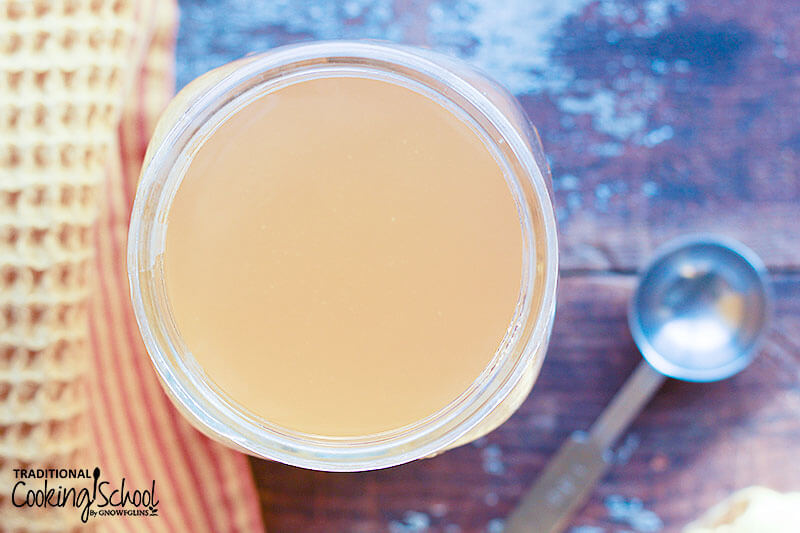
What’s your favorite use for this amazing natural remedy?
Other Fermented Recipes
- Homemade Sauerkraut In A Stoneware Crock
- Simple, No-Pound Sauerkraut
- High Vitamin C Sauerkraut
- Homemade Kimchi: An Easy Korean Sauerkraut Recipe
- Old-Fashioned, Crunchy, Fermented Garlic-Dill Pickles
- Lacto-Fermented Carrot Sticks
- 5-Spice Apple Chutney {lacto-fermented!}
- Spontaneously Fermented Sparkling Apple Cider {fall’s easiest ferment!}
- Lacto-Fermentation archiveshere at Traditional Cooking School
...without giving up the foods you love or spending all day in the kitchen!

2 free books:
Eat God's Way
Ditch the Standard American Diet, get healthier & happier, and save money on groceries...
We only recommend products and services we wholeheartedly endorse. This post may contain special links through which we earn a small commission if you make a purchase (though your price is the same).


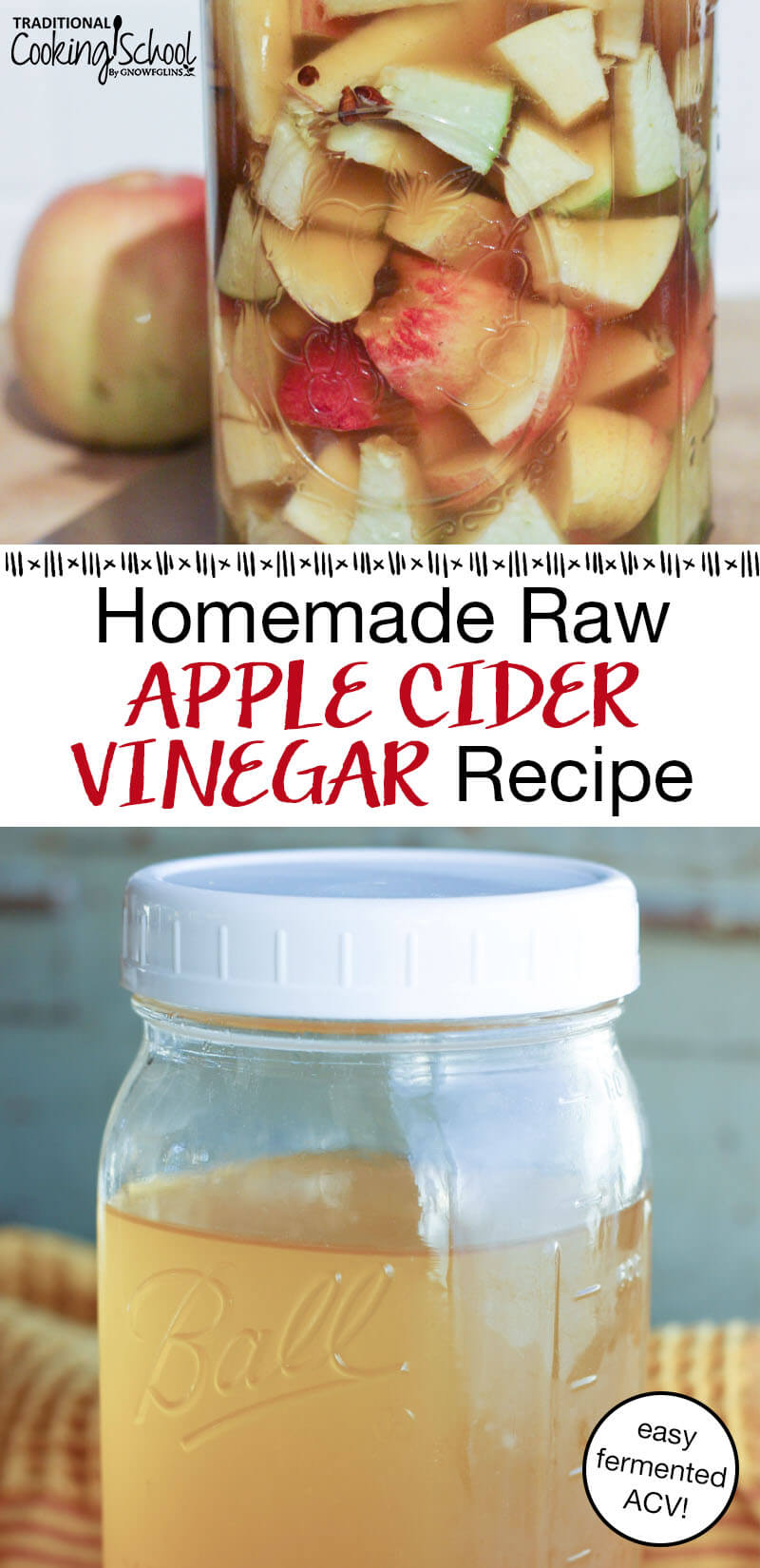
Yum, I love a good apple cider vinegar! This is such a great way to ferment it, thank you for sharing!
Thanks for your comment, Brittany! 🙂
Hi Megan, why is there so much carbs and sugar in this recipe for homemade apple cider vinegar as seen on the nutritional facts?
Hi Patricia, I’m glad you asked that, and good observation. Unfortunately, the nutritional facts are picking up on the data for the original ingredients, instead of the finished product. During the fermentation, the sugars are consumed. Here is the nutritional information for completed apple cider vinegar: Serving size: 2 tablespoons | Calories: 6 kcal | Carbohydrates: 0.3 g | Sodium: 1 mg | Sugar: 0.1 g 🙂
Merry Christmas!!!
I know this is likely a silly question, but how long should I keep the newly made ACV in the Instantpot?
I am anxious to make my own ACV!!!!!!!
I have a busy life working and taking care of the house, my wife ( she is recovering from knee replacement, 3 dogs, and a cat. I would like to start using an Instant Pot to make dog and was wondering to help save me some time could I soak the rice in the commercial ” Mother’s” Aple Cider Vinager. Thanks and hope you have time for your opinion. Happy New Year!
Last fall I cooked crab apples and canned the pure juice with nothing added. Could I use the juice to make this or do I need to use raw apples?
Have a small question that I’m not clear about…when you say set-in warm dark place for 2 weeks…the seed mat or the Instant pot Has to be continuously on??? For 2 weeks?
Hi Kevin, I just turn my IP on Yogurt setting in the evenings when the house is cool, then off during the day but still covered once the house is warmed up. The warmth from overnight under the towel keeps the ferment going inside the IP. If the house is cold during the day, then I turn my IP back on. The seed mat should be plugged in constantly.
How warm is warm? If it is in the 80s outside could I put it in a cabinet in the garage?
Hi Debbie, yes, that sounds fine … except the key is a warm steady temperature, so if your garage gets cooler in the evenings, it’s ideal to have a warming mat, or to wrap it in a towel if it only dips a little.
Great recipe! When I finally have my vinegar… how should I store it?
Refrigerator or dry place (no sun)
With cheescloth or bottle cap
Thank you!!!
Hi Mayli, Once your ACV is made, it is true vinegar, a preserved product. Apple cider vinegar lasts indefinitely at room temperature with lid.
It is fantastic . I can prepare easily at home. Thanks a lot.
Is it normal for a mold to grow on the top of juice?
I started to make it , I used honey instead of sugar. After two weeks before straining some of the jars had black flecks on the apples another mold . The water did not completely cover the apples , could this be a reason why it grew mold ? Is it still safe to use the strain juice to make the vinegar
Hi Sharon, was your ferment plenty warm and a consistently/steady warm temperature? And it depends how far above the liquid the apples were. I would not consume it, if it’s truly mold and not kahm yeast.
I have made RACV for several years and have a few scobys waiting for their chance to be used! I highly recommend your method! Now the challenge: our pear tree is literally breaking apart from so many fruits. It’s so tall that I couldn’t thin out the fruit on the upper branches (20ft+). I am thinking about trying to make some pear vinegar using this recipe as a guide.
What are your thoughts on the following method. I am thinking I will have to make pear wine (or cider) if I can find the recipe again and then proceed to ferment the juice. I don’t know if the time frame would be similar and if I would need to add more sugar.
Help!
Hi Diane, pear vinegar and hard cider sound so delicious and special. I would follow the recipe above exactly and see what happens, because then you’ll have a baseline from which to tweak anything if you feel a change is needed. This recipe does indeed make a hard cider after 2 weeks that is so lovely and smells just charming. Please let us know how you do!
I have a batch of ACV fermenting in a warm dark place and started a second batch with the fermented apples. How long should I let this ferment before I strain it?
Hello,
Can’t believe sugar or honey wasn’t mentioned as part of the ingredients when I was taught. My apples has been in a jar now for 3weeks placed in a warm dark space, can I still add sugar or honey? Will it still ferment?
I started my apple cider vinegar fermentation 2 1/2 weeks ago. Using the Apple core and peels from our apple tree. I used a cheese cloth and thin towel over the top of the 5 gallon bucket but unfortunately fruit flies found their way into it. They were several hundred dead at the top. I have strained everything out but am curious if my vinegar is ruined. I know it’s still needs to sit for another four weeks now that everything has been removed but I’m hesitant to consume because of the flys that were in in. Has it been ruined or still safe? Also, any advice on how to prevent the fruit flys from getting to it in the future?
Hi Ashley, sorry to delay in my response; I was on a short vacation. 🙂 Your ACV is fine and safe. Ferments are wonderful ecosystems of health, and nothing bad can survive in vinegar. I would use a metal screw-on ring (from a 2-piece lid) and a coffee filter screwed on beneath it. Blessings!
I just checked on mine, and it’s full of dead fruit flies, and tiny little seeds, possibly eggs, and tiny worms. Not sure if I should keep the 5 gallons or not. We tried two gallon jars with no sugar, and they’re the worst. Any advice?
Hello Megan
We have an abundance of apples this year.. and instead of letting most of them compost I’m going to make my own ACV. I noticed you had your jar sitting in the Instant Pot. Did you leave it there for 2 weeks, surely not? I must have misunderstood.
I’m planning to leave the jars on the counter and gues it will take a little longer. Do you know if it will interact with my continuous brew kombucha ??
Hi Wendy, in the cooler months, I use my IP off and on, yes, for 2 weeks, when making ACV. When the house is warm, during the days, I turn it off. All night, I use it on the Yogurt setting. Now, in the summer, if you keep your house on the warmer side, you can ferment at warm room temperature. A seedling mat is also GREAT for maintaining a steady warm temp. I prefer that route to no source of steady warm heat, especially when you first start the ferment and want to get it off on the right foot. For your two ferments, I’d definitely keep them apart by about 6 feet.
I bought my Apple cider vinegar from a shop, and kept it in a refrigerator,can I use it? Thanks
Hi thanks for the recipe. I’ve got a question is that TBS for each cup of water only for the honey or does that pertain to only honey? Could you explain the “mother” of apple cider? So many recipes it can be much sometimes.
It’s great. I can make it at my home. I am very excited. I want try it.
Do you think I could make this with flavored sweetened tea? I have a mango, hibiscus herbal tea that I would like to try.
Hi, Kristin.
We have not made this into a flavor sweet tea of any kind but you could try it. 🙂
~Danielle, TCS Customer Success Team
These cookies are SO DELICIOUS. I love this recipe! It’s my third time making them and I swear they get better each time!
I do not have any apple trees in my garden. All the apples in our stores have been sprayed with insecticide. Can I use these? I am looking forward to making this vinegar.
Thank you.
Can homemade apple cider vinegar with mother be canned using water bath canning?
Hi Christina, no, heat will kill the raw, probiotic quality.
Thanks so much for sharing this great recipe! Quick question – is the sugar necessary for anything besides taste? We’re a very low sugar family, and if it’s just for taste, I’d leave it out, but wondering if it’s needed for fermenting. Thanks so much!
Hi Angelica, the sugar is consumed during fermentation, so you and your family will not be taking it in. And it is necessary for that process. Cheers.
So informative to me! Useful recipe.. Thank you much for sharing that.
How to sterilise the Glass bottles for packing and storage
Oh! I’ve just discovered your website! Loving it!
And this article is so well explained, I now understand completely what to do for ACV (which we use heaps of!)
Thank you!!!!
quick question…….. may sound silly but im curious…… how does the smell of the acv smell during fermenting?? this is my first time fermenting apples. i have fermented cabbage for saurkuart before but never apples and im just curious as to how it is suppose to smell?
I made some with no honey or sugar, placed plastic wrap over- in a mason jar. It just sits out on the cabinet. It’s little bubbles are everywhere, should I start over as I didn’t use cheese cloth?
I followed the steps of this recipe. After two weeks, I removed solids and placed back in warm spot. It’s been 7 weeks and it still does not have ACV smell. It has that fermentation smell it did since I removed the solids. Should I give up on it? My main question is how do you tell if your fermentation process went bad?
I used organic store bought ACV to inoculate my first batch of vinegar, after the apples turned into cider. Since then I use some of the mother to help my next batch develop a mother and turn into vinegar.
My mother in-law and others from her age back (96) this year use to make vinegar from water, molasses, and sugar, they called the mother a vinegar plant. It was a tasty homemade vinegar also.
It’s not actual Apple cider vinegar which is made from cider. But nice apple scrap vinegar!
Yes there is a difference!
After the vinegar is ready, is it to be stored in the fridge or can I bottle it and leave it in the pantry?
Thank you for the recipe!
You can bottle it and leave it on the shelf. ACV is shelf stable.
Can you freeze cores as you use them until you accumulate enough to make the vinegar?
Yes
What can we do with the leftover apples after making the apple cider vinegar? Can it be eaten or it has to be thrown out and composted?
Hi, Yoko.
They are best in the compost pile.
~Danielle, TCS Customer Success Team
I made acv using apples and its now three months but no mother has formed though vinegar has been achieved how do I grow the mother should I add more sugar to the vinegar and wait a few more months?
Ooh! I just made some dehydrated apple chips for the kids (They love apple chips), this is a perfect way to deal with the scraps! I have a friend who uses organic apple cider for everything, and I’m already buying organic apples for the apple chips (I just bought trees to grow my own, but they aren’t producing yet) Two birds stoned at once haha!
Hello. Please can you tell me if I could use a silicon cover below the neck of the jar to keep the apples submerged? Or does it need more air? Thanks in advance.
Yes I thought you had to keep apple submerged but it doesn’t say to in recipe?
Wow! That seems easy enough! Thanks for sharing.
Great post! It is easy and detailed to follow. Thanks!
Easy recipe, my family LOVES them! Will definitely be making again, thank you so much for the awesome recipe!
What would I need to do if I want a “darker” ACV?
hi, i am currently in the 4th week of making this vinegar, and i have noticed a white film forming on the top. is this the mother? What do i do in 2 weeks time when its time to bottle the vinegar. Do i remove the mother, and strain into a clean bottle?
Same here! It’s like a foamy white film – kinda yellow around the edge of the jars.
You can dig deeper into ACV. Like all vinegars it is as much a flavor enhancer as a souring ingredient. A tablespoon or two, not enough to taste in soups, stews, chili, and on roasts, and other braised and roasted meats, do wonders to enhance regular flavors.
I like the recipe so much. Thank you for your sharing!
Could ACV be made with crab apples? Do you know how it would taste?
I have a good mother going in two bottles that I have just strained. What should I do with it? Thanks for a great recipe!
I am following your recipe and I’m 5 days in. I have it in a jar and a 5 gallon bucket, on top of a heating pad. The apples on top are starting to mold.
This happened to me when I tried making ACV a few years ago to. What am I doing wrong ??
I love this easy homemade recipe, thanks for sharing.
Why do you remove the apple cubes before the fermentation process is done? Do I have to strain the apple cubes out? Or can I leave the apple in the jar for the entire fermentation process?
Thanks 🙂
Hi. Thank you for the recipe. I accidentally put too much sugar in my ACV while making it. I am on day 2 of the ferment. Should I start over with a new batch and lower the sugar content? I put 10 Tablespoons of sugar instead of 5
Also, I stirred it today and noticed some of the apples were brown on top. Is this normal to be browning so quickly into the ferment? I do have a weight on top of the apples so no air should be getting in.
Hi there, we are trying to make our own ACV and it has been fermenting for about 3 week now. Last week we strained it and put it back in the crock pot.
Mind you this is a 5 gallon crock pot, my husband doesn’t do small. It is covered and in a warm place, My husband says it smells like alcohol and I say it still smells like apples. Next week I know he is going to want to do something with it. How do you know the acidity of it and can we use this like store bought ACV like cooking or canning.
No you cannot can with this ACV.
Yes, you can cook with it.
The alcohol smell is a part of the fermentation process. Give it a few more weeks to finish.